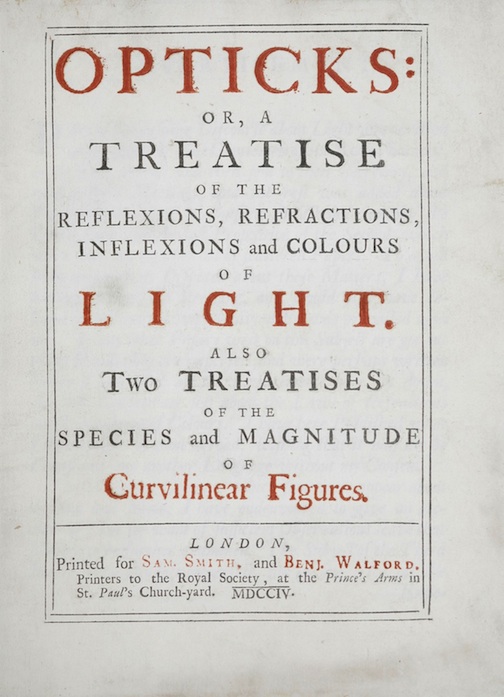|
|
|
|
|
|
|
|
|
|
|
|
|
|
|
|
| NEWTON, Isaac
|
| Opticks: or a treatise of the reflexions, refractions, inflections and colours of light
|
| London: Smith and Walford, 1704.
|
| First edition, first issue.
|
| 4to.
|
| Contemporary English paneled calf (rebacked).
|
|
|
|
|
|
|
|
|
|
|
|
|
|
This is the second of Newton's two monumental contributions to science, the other being the Principia. Unlike prior books on optics, which are mainly concerned with the geometrical properties of light reflection and lensing, Newton's treatise takes up the physical properties of light, determined via experiments. Whereas the Principia is a theoretical treatise of deductive reasoning - i.e., a philosophical investigation in the tradition of his great rival Descartes - the Opticks is an empirical treatise of induction from experiment and observation, more in the tradition of Francis Bacon.
|
|
|
|
The Opticks was written in English (the language of the common man), while the Principia appeared in Latin (the language of the scholar). It is perhaps also notable that Newton's name and Cambridge affiliation appear prominently on the title page of the first edition (1687) of the Principia, but the title page of the Opticks does not identify its author. This prompts some interesting speculations about Newton's personality and prejudices. He was a difficult, quarrelsome man who didn't get along with very many people. While he was preparing the Principia he considered publishing it in English but rejected that plan in favor of Latin, because he didn't want it to be read by ordinary people, who he assumed would not understand it and would then pester him with ignorant and stupid questions ("To avoid being baited by little smatterers in mathematics, I designedly made the Principia abstract; but yet as to be understood by able mathematicians"). Even in its day, the formal and abstract content of the Principia was accessible to only a few mathematicians; today it is essentially incomprehensible. In contrast, the Opticks is written as a popular exposition for a general audience, and even today is quite readable. This suggests that Newton embraced the traditional distinction between episteme and techne (i.e., theory and practice) that permeated medieval and renaissance culture, with the former the preserve of the elite intellectual class and the latter the appropriate practical pursuit of the working commoner. The respective title pages would suggest that he clearly identified with the former. One can see a parallel in the matter of music theory and practice in the renaissance. The subject of Music, as part of the quadrivium of liberal studies taught to men of leisure (hence liberated) at a university, was a strictly theoretical analysis of the mathematics of scales and harmony, suitable for contemplation by an educated amateur, while the actual performance of music was a practical trade to be learned "on the street", so to speak.
|

